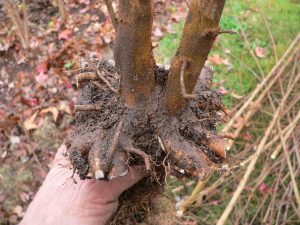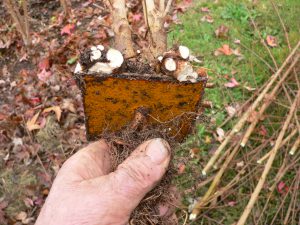 Some of you may have noted the evenly spread roots on the trident maples in the previous post. Those of you who have been following for a while or who have been back through earlier posts will already be aware that nebari like that is not just a coincidence.
Some of you may have noted the evenly spread roots on the trident maples in the previous post. Those of you who have been following for a while or who have been back through earlier posts will already be aware that nebari like that is not just a coincidence.
 Here’s the same trident maple from below. The original trunk that was threaded through the hole in the aluminium plate is still visible and functioning. As it grows a little thicker, circulation will be further restricted and it will gradually die off but the new roots above the plate are now strong and healthy enough to support the tree.
Here’s the same trident maple from below. The original trunk that was threaded through the hole in the aluminium plate is still visible and functioning. As it grows a little thicker, circulation will be further restricted and it will gradually die off but the new roots above the plate are now strong and healthy enough to support the tree.
More pictures and a full description in the 12-Aug 2017 post – Develop great nebari #2
I often see other bonsai enthusiasts promoting similar methods using different plate materials.
Some use metal washers but I think those are far too small to be effective but if a large washer is all you can get why not try it out.
Others have talked about planting seedlings through the hole in a CD or DVD. These are cheap and easy to obtain now but the central hole is relatively large so it will take some time before the trunk is constricted sufficiently to initiate new roots above. CD plastic is also relatively flimsy so I think the developing roots may actually break the disc. My earliest attempts at this technique used ceramic tiles which were hard to drill without shattering. I also tried cement sheet (building product). After a couple of years both these materials had been reduced to tiny pieces by the force of growing roots and so had not really achieved the best outcomes in terms of nebari.
Although there is lots of advice about using both metal washers and CDs in various places there seems to be very few pictures of the results. Although not all of the trees I grow this way produce perfect nebari I have found this to be the most effective and repeatable method I have used so far.
